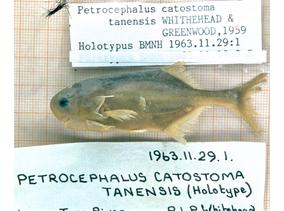Vous êtes ici
Mormyridae
Petrocephalus tanensis Whitehead & Greenwood 1959
Nomenclature
-
Subfamily: PetrocephalinaeGenus: Petrocephalus
SUMMARY
Original description from Whitehead and Greenwood (1959):
Petrocephalus c. tanensis agrees in all characters with P. c. catostoma but has more dorsal fin-rays (III.22.25 [mode 24]).
Expanded description from Kramer et al (2012):
Body oval shape, dorsally deep and rounded, ventrally rather flat. Head broadly rounded with a small ventrally positioned subterminal mouth, situated ventral to the eye; head and body dorsolaterally compressed. Dorsal fin (a) origin situated almost two-thirds of standard length from snout, (b) obliquely orientated, anteriorly higher and posteriorly lower, (c) distal margin crescentic with anterior two or three rays longer than posterior rays, and (d) number of rays 22 (n = 1), 23 (n = 12), 24 (n = 19), 25 (n = 18), 26 (n = 2). Anal fin (a) longer than dorsal fin, (b) opposite dorsal fin with slightly more anterior origin, (c) obliquely orientated, anteriorly lower and posteriorly higher, (d) anterior 10 or so rays longer than posterior ones, especially in males where they also appear stronger, (e) margin broadly rounded, (f) rays posterior to first 10 with distal margin straight, (g) number of rays 26 (n = 1), 27 (n = 16), 28 (n = 24), 29 (n = 13). Forked tail fin with rounded lobes. Scales cycloid with reticulate striae, scales extending anteriorly to operculum and pectoral fins (beyond pelvics). Scales in lateral series, 36 (n = 12), 37 (n = 14), 38 (n = 1). Scales on caudal peduncle circumference, 12 (n = 37), 13 (n = 2), 14 (n = 14). Caudal peduncle slender, subcylindrical entire length, usually 22.3% (19.3–24.7%) of SL.
Electric organ discharge a triphasic pulse with strong head-positive phase P1 followed by head-negative main phase N, and weaker head- positive P2 phase; P2 phase stronger in males than in females of same size. Pulse duration, median 403 (312–735) μs in females (n = 15), and shorter median, 307 (276–391) μs, in males (n = 1 5); 25◦C, 2% threshold criterion.
Males with kink in anal fin base which is absent in juveniles and females where the anal fin base is straight.
Colour in life: grey-silver, underside lighter, paired fins light and transparent.
Colour in preservation: light ochre.


